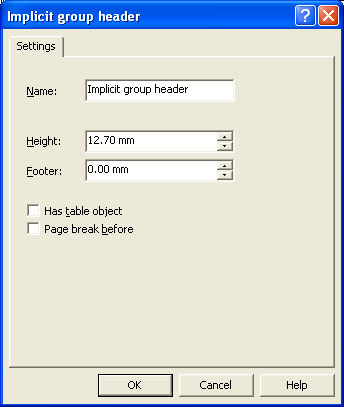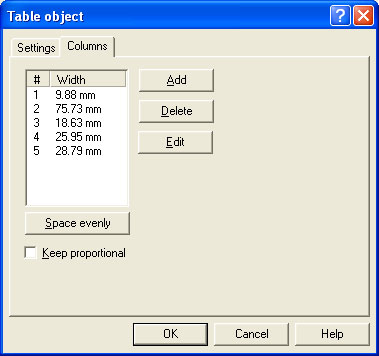| Design and Objects |

|

|
| |
| Objects |
 |

|
 |
| |
| Page
Elements |

|

|

|

|

|

|

|

|

|

|

|

|
 |

|

|
|
| Creating Page Elements |
 |
|
Group headers print heading information that appears at the top of a
group of detail lines and automatically at the top of subsequent pages
for this group. There are two types of group headers:
- Explicit
group header - an explicit group header is
found in the input file and consists of constant or variable heading
information.
- Implicit
group header - an implicit group header is
assigned by FormTrap to a detail line and consists of constant heading
information.
|
| Explicit group header |
|
An explicit group header is found in the input file. On a records mode
form, when explicit group headers are created they are assigned a
letter of the alphabet, lowercase a through j,
as a unique identifier. When FormTrap sees an a - j
identifier in the first column of the input file record it will print
the corresponding explicit group header.
To add an explicit group header:
|
|
| Top
|
| Implicit group header |
|
An implicit group header contains constant heading information and
prints at the top of a group of detail lines. The implicit group header
is associated with a specific detail line or a group of detail lines.
When that detail line is first found in the input file, the implicit
group header will print before the detail line as a group heading.
To add an implicit group header:
- From the Define
menu, select Add group header and then
Implicit.
- On the Settings
tab, set:
- Name -
the name is used as a reference for the group header.
- Height -
set the height of the group header to accommodate the constant text
objects that represent the detail information and any additional
formatting objects.
- Footer -
space between the end of the current table object and the next table
object.
- Has table object
- table for the current group of detail lines is printed with the group
header.
- Page break before
- a new page will be generated before the group header prints.

After the implicit group header is defined
it is then associated with a detail line.
|
|
| Top
|
| Has table object |
|
If the Has table object box has been
checked FormTrap will create a table using the associated explicit or
implicit group header at the top of the table. The table object will
create a border around the Detail Area. If a new explicit or implicit
group header is called the current table object terminates and a new
table object with a new header is created.
The newly created group header is outlined
by a black rectangle. This black rectangle represents the table object
and its properties can be edited to change the color and style of the
table printed. The table object columns can also be created and
positioned graphically on your form.

To edit the table object:
- Double click on the table object.
- On the Settings
tab set:
- Border -
set the border style to Thin, Thick
or Double.
- Rounded at the top
- check the box to give the top of the table rounded corners.
- Rounded at the bottom
- check the box to give the bottom of the table rounded corners.
- Colors -
select a section of the table, e.g. border color, and then click the Edit...
button to change the color of the section. Click the Transparent
button to make that section of the table transparent.
- Fill Detail Area
- check the box to have the table fill to the end of the Detail Area,
regardless of how many detail lines are printed on the page.

- On the Columns
tab, add and modify the columns for the table. You can also create and
reposition column lines graphically on the form itself.
- Add -
click the Add button to add a new column
and enter the column width.
- Edit -
select a column and click the Edit button
to edit the column width.
- Delete -
select a column and click the Delete
button to delete a column.
- Space evenly
- click the Space evenly button to make
all columns an equal width.
- Keep proportional
- if checked, the columns within the table object remains proportional
when the object is resized.

- Click the OK
button.
To edit the table object columns graphically
on your form:
- Right click on the table object and
select Edit Columns from the drop down
menu.
- Right click and select Insert
Columns.
- Click within the table object to insert a
new column line. Continue to insert as many column lines as you need in
your table object.
- Once you have finished inserting columns,
right click within the table object and select End
Inserting Columns from the drop down menu. You can
insert new column lines by right clicking and selecting Insert
Columns from the drop down menu.
- To move a column line within the table
object, click to select the column line and drag it to the desired
position or use the arrow keys on your keyboard to nudge
the line.
- Once you have finished editing the
columns in the table object, right click within the table object and
select Accept Changes to save the changes
to the table object columns, or Cancel Changes
to discard the changes to the table object columns.
|
|
| Top
|
|
|
|


